Enhancing Public Health through Electronic Health Records
VerifiedAdded on 2020/04/15
|7
|1607
|120
AI Summary
The assignment examines the integration of Electronic Health Records (EHR) to enhance public health initiatives by improving collaboration between healthcare providers and public health entities. It explores how EHR systems facilitate better data collection, real-time surveillance, and more effective responses to public health threats. The discussion includes case studies such as New York City's efforts with Take Care New York and West Nile Virus monitoring, highlighting the benefits of leveraging EHR for chronic disease management and outbreak prevention.
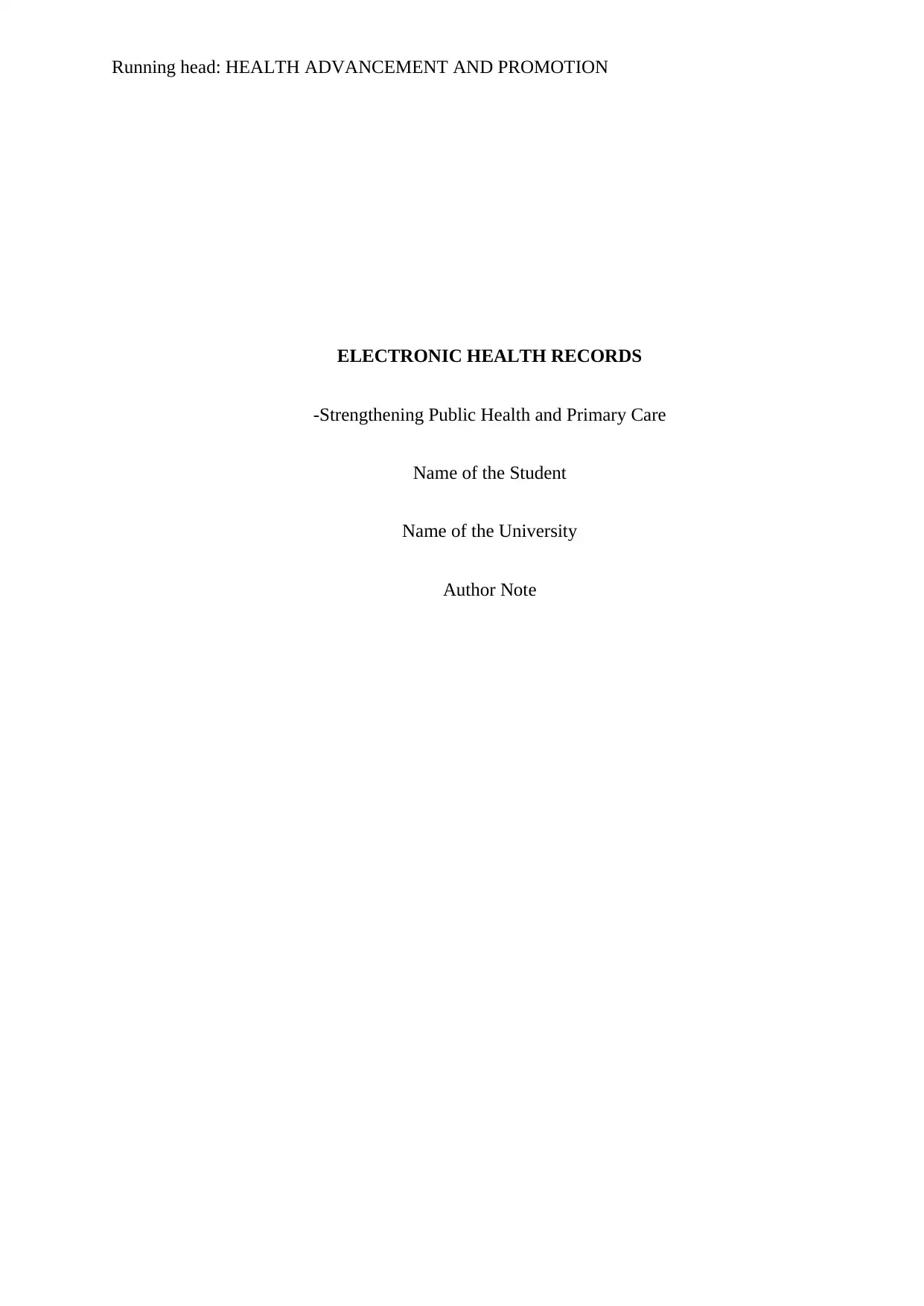
Running head: HEALTH ADVANCEMENT AND PROMOTION
ELECTRONIC HEALTH RECORDS
-Strengthening Public Health and Primary Care
Name of the Student
Name of the University
Author Note
ELECTRONIC HEALTH RECORDS
-Strengthening Public Health and Primary Care
Name of the Student
Name of the University
Author Note
Paraphrase This Document
Need a fresh take? Get an instant paraphrase of this document with our AI Paraphraser
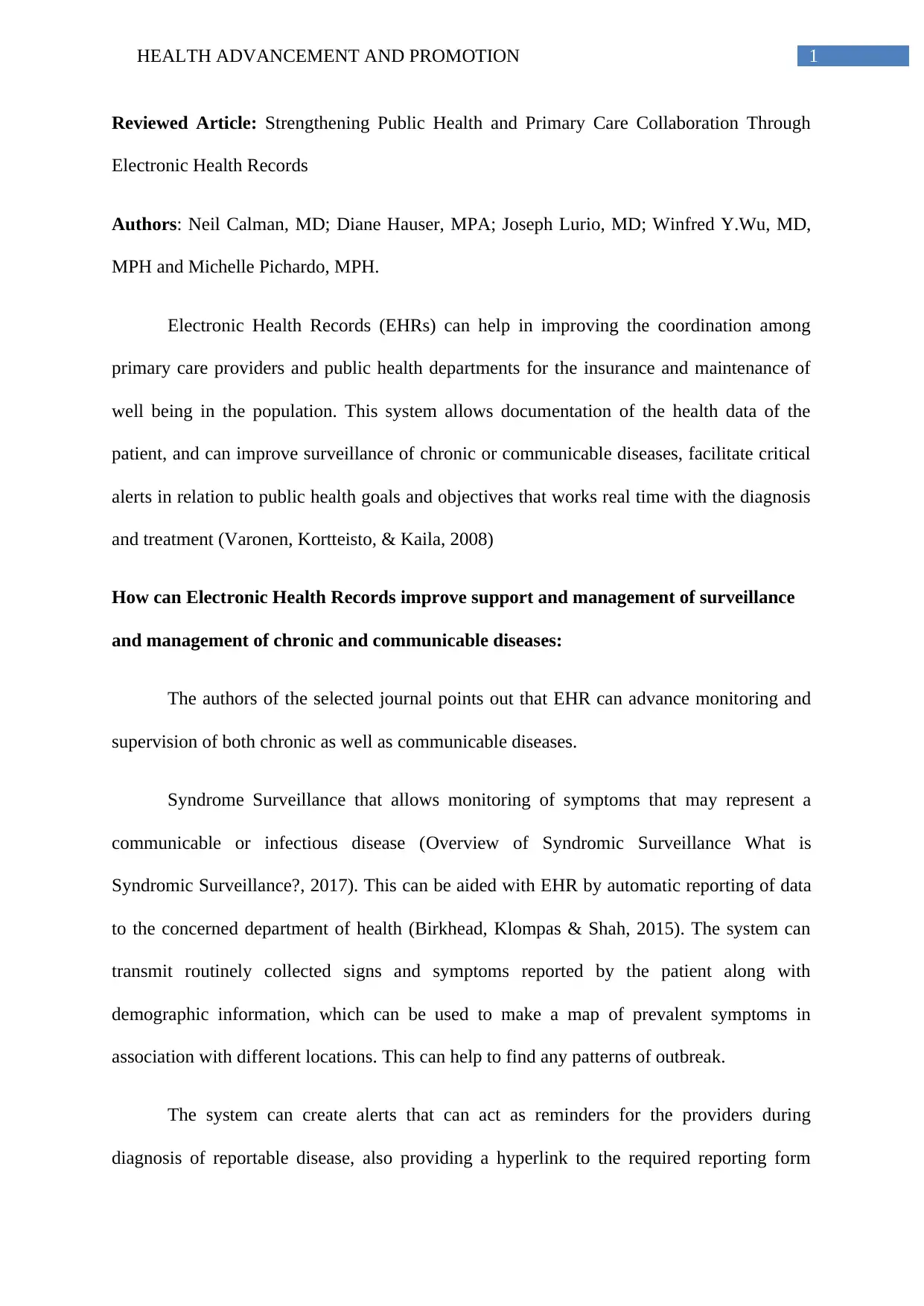
1HEALTH ADVANCEMENT AND PROMOTION
Reviewed Article: Strengthening Public Health and Primary Care Collaboration Through
Electronic Health Records
Authors: Neil Calman, MD; Diane Hauser, MPA; Joseph Lurio, MD; Winfred Y.Wu, MD,
MPH and Michelle Pichardo, MPH.
Electronic Health Records (EHRs) can help in improving the coordination among
primary care providers and public health departments for the insurance and maintenance of
well being in the population. This system allows documentation of the health data of the
patient, and can improve surveillance of chronic or communicable diseases, facilitate critical
alerts in relation to public health goals and objectives that works real time with the diagnosis
and treatment (Varonen, Kortteisto, & Kaila, 2008)
How can Electronic Health Records improve support and management of surveillance
and management of chronic and communicable diseases:
The authors of the selected journal points out that EHR can advance monitoring and
supervision of both chronic as well as communicable diseases.
Syndrome Surveillance that allows monitoring of symptoms that may represent a
communicable or infectious disease (Overview of Syndromic Surveillance What is
Syndromic Surveillance?, 2017). This can be aided with EHR by automatic reporting of data
to the concerned department of health (Birkhead, Klompas & Shah, 2015). The system can
transmit routinely collected signs and symptoms reported by the patient along with
demographic information, which can be used to make a map of prevalent symptoms in
association with different locations. This can help to find any patterns of outbreak.
The system can create alerts that can act as reminders for the providers during
diagnosis of reportable disease, also providing a hyperlink to the required reporting form
Reviewed Article: Strengthening Public Health and Primary Care Collaboration Through
Electronic Health Records
Authors: Neil Calman, MD; Diane Hauser, MPA; Joseph Lurio, MD; Winfred Y.Wu, MD,
MPH and Michelle Pichardo, MPH.
Electronic Health Records (EHRs) can help in improving the coordination among
primary care providers and public health departments for the insurance and maintenance of
well being in the population. This system allows documentation of the health data of the
patient, and can improve surveillance of chronic or communicable diseases, facilitate critical
alerts in relation to public health goals and objectives that works real time with the diagnosis
and treatment (Varonen, Kortteisto, & Kaila, 2008)
How can Electronic Health Records improve support and management of surveillance
and management of chronic and communicable diseases:
The authors of the selected journal points out that EHR can advance monitoring and
supervision of both chronic as well as communicable diseases.
Syndrome Surveillance that allows monitoring of symptoms that may represent a
communicable or infectious disease (Overview of Syndromic Surveillance What is
Syndromic Surveillance?, 2017). This can be aided with EHR by automatic reporting of data
to the concerned department of health (Birkhead, Klompas & Shah, 2015). The system can
transmit routinely collected signs and symptoms reported by the patient along with
demographic information, which can be used to make a map of prevalent symptoms in
association with different locations. This can help to find any patterns of outbreak.
The system can create alerts that can act as reminders for the providers during
diagnosis of reportable disease, also providing a hyperlink to the required reporting form
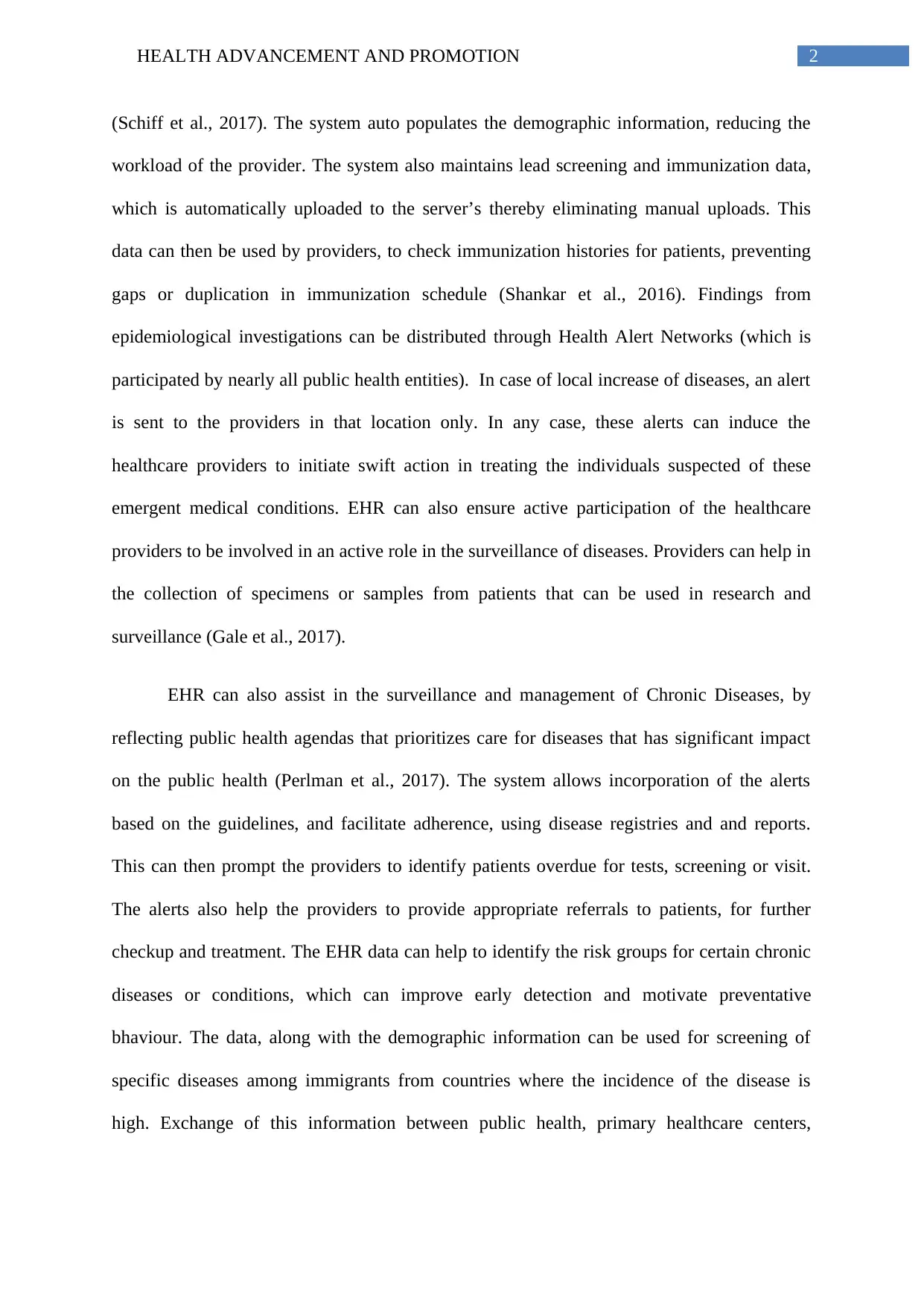
2HEALTH ADVANCEMENT AND PROMOTION
(Schiff et al., 2017). The system auto populates the demographic information, reducing the
workload of the provider. The system also maintains lead screening and immunization data,
which is automatically uploaded to the server’s thereby eliminating manual uploads. This
data can then be used by providers, to check immunization histories for patients, preventing
gaps or duplication in immunization schedule (Shankar et al., 2016). Findings from
epidemiological investigations can be distributed through Health Alert Networks (which is
participated by nearly all public health entities). In case of local increase of diseases, an alert
is sent to the providers in that location only. In any case, these alerts can induce the
healthcare providers to initiate swift action in treating the individuals suspected of these
emergent medical conditions. EHR can also ensure active participation of the healthcare
providers to be involved in an active role in the surveillance of diseases. Providers can help in
the collection of specimens or samples from patients that can be used in research and
surveillance (Gale et al., 2017).
EHR can also assist in the surveillance and management of Chronic Diseases, by
reflecting public health agendas that prioritizes care for diseases that has significant impact
on the public health (Perlman et al., 2017). The system allows incorporation of the alerts
based on the guidelines, and facilitate adherence, using disease registries and and reports.
This can then prompt the providers to identify patients overdue for tests, screening or visit.
The alerts also help the providers to provide appropriate referrals to patients, for further
checkup and treatment. The EHR data can help to identify the risk groups for certain chronic
diseases or conditions, which can improve early detection and motivate preventative
bhaviour. The data, along with the demographic information can be used for screening of
specific diseases among immigrants from countries where the incidence of the disease is
high. Exchange of this information between public health, primary healthcare centers,
(Schiff et al., 2017). The system auto populates the demographic information, reducing the
workload of the provider. The system also maintains lead screening and immunization data,
which is automatically uploaded to the server’s thereby eliminating manual uploads. This
data can then be used by providers, to check immunization histories for patients, preventing
gaps or duplication in immunization schedule (Shankar et al., 2016). Findings from
epidemiological investigations can be distributed through Health Alert Networks (which is
participated by nearly all public health entities). In case of local increase of diseases, an alert
is sent to the providers in that location only. In any case, these alerts can induce the
healthcare providers to initiate swift action in treating the individuals suspected of these
emergent medical conditions. EHR can also ensure active participation of the healthcare
providers to be involved in an active role in the surveillance of diseases. Providers can help in
the collection of specimens or samples from patients that can be used in research and
surveillance (Gale et al., 2017).
EHR can also assist in the surveillance and management of Chronic Diseases, by
reflecting public health agendas that prioritizes care for diseases that has significant impact
on the public health (Perlman et al., 2017). The system allows incorporation of the alerts
based on the guidelines, and facilitate adherence, using disease registries and and reports.
This can then prompt the providers to identify patients overdue for tests, screening or visit.
The alerts also help the providers to provide appropriate referrals to patients, for further
checkup and treatment. The EHR data can help to identify the risk groups for certain chronic
diseases or conditions, which can improve early detection and motivate preventative
bhaviour. The data, along with the demographic information can be used for screening of
specific diseases among immigrants from countries where the incidence of the disease is
high. Exchange of this information between public health, primary healthcare centers,
⊘ This is a preview!⊘
Do you want full access?
Subscribe today to unlock all pages.

Trusted by 1+ million students worldwide
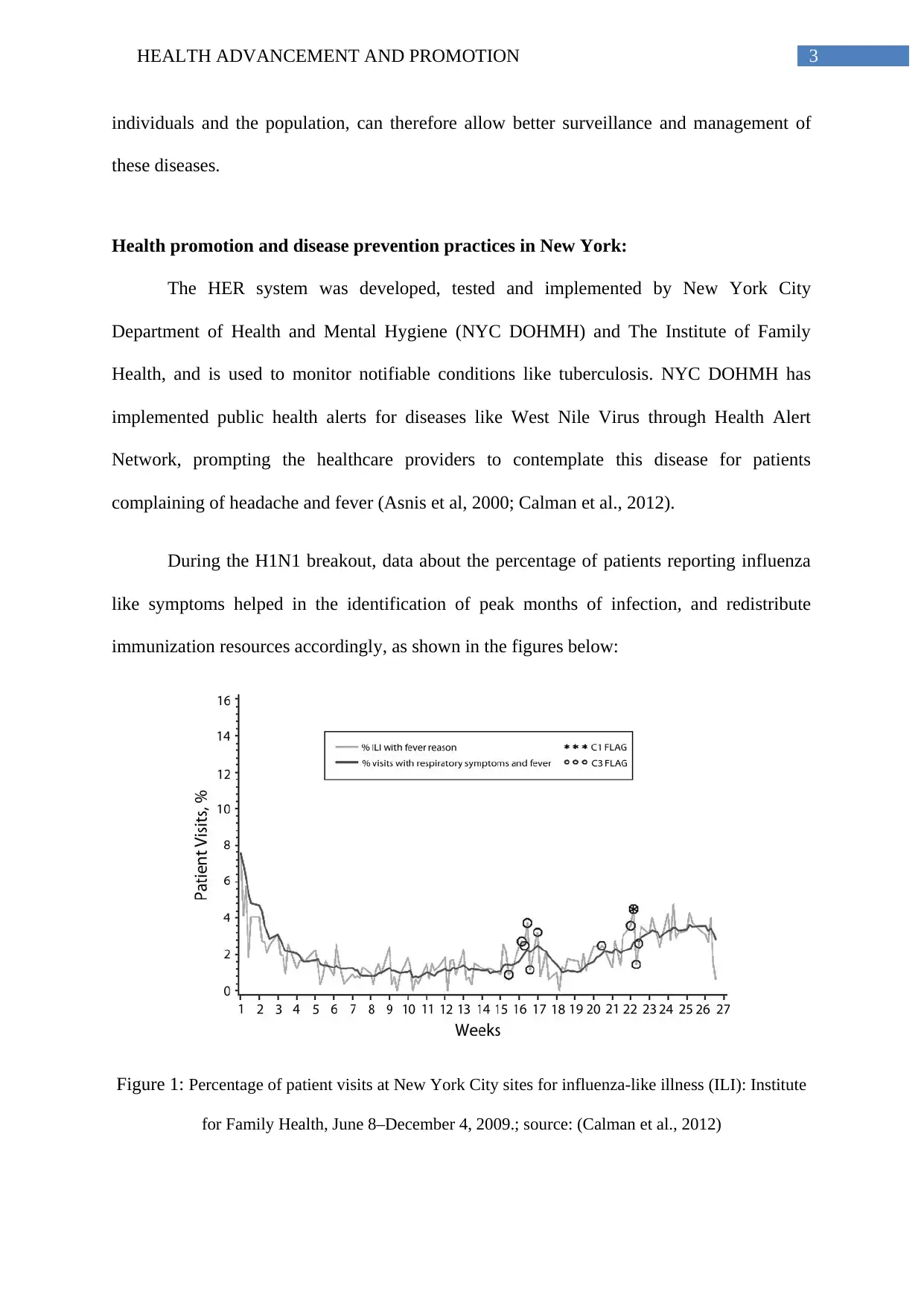
3HEALTH ADVANCEMENT AND PROMOTION
individuals and the population, can therefore allow better surveillance and management of
these diseases.
Health promotion and disease prevention practices in New York:
The HER system was developed, tested and implemented by New York City
Department of Health and Mental Hygiene (NYC DOHMH) and The Institute of Family
Health, and is used to monitor notifiable conditions like tuberculosis. NYC DOHMH has
implemented public health alerts for diseases like West Nile Virus through Health Alert
Network, prompting the healthcare providers to contemplate this disease for patients
complaining of headache and fever (Asnis et al, 2000; Calman et al., 2012).
During the H1N1 breakout, data about the percentage of patients reporting influenza
like symptoms helped in the identification of peak months of infection, and redistribute
immunization resources accordingly, as shown in the figures below:
Figure 1: Percentage of patient visits at New York City sites for influenza-like illness (ILI): Institute
for Family Health, June 8–December 4, 2009.; source: (Calman et al., 2012)
individuals and the population, can therefore allow better surveillance and management of
these diseases.
Health promotion and disease prevention practices in New York:
The HER system was developed, tested and implemented by New York City
Department of Health and Mental Hygiene (NYC DOHMH) and The Institute of Family
Health, and is used to monitor notifiable conditions like tuberculosis. NYC DOHMH has
implemented public health alerts for diseases like West Nile Virus through Health Alert
Network, prompting the healthcare providers to contemplate this disease for patients
complaining of headache and fever (Asnis et al, 2000; Calman et al., 2012).
During the H1N1 breakout, data about the percentage of patients reporting influenza
like symptoms helped in the identification of peak months of infection, and redistribute
immunization resources accordingly, as shown in the figures below:
Figure 1: Percentage of patient visits at New York City sites for influenza-like illness (ILI): Institute
for Family Health, June 8–December 4, 2009.; source: (Calman et al., 2012)
Paraphrase This Document
Need a fresh take? Get an instant paraphrase of this document with our AI Paraphraser
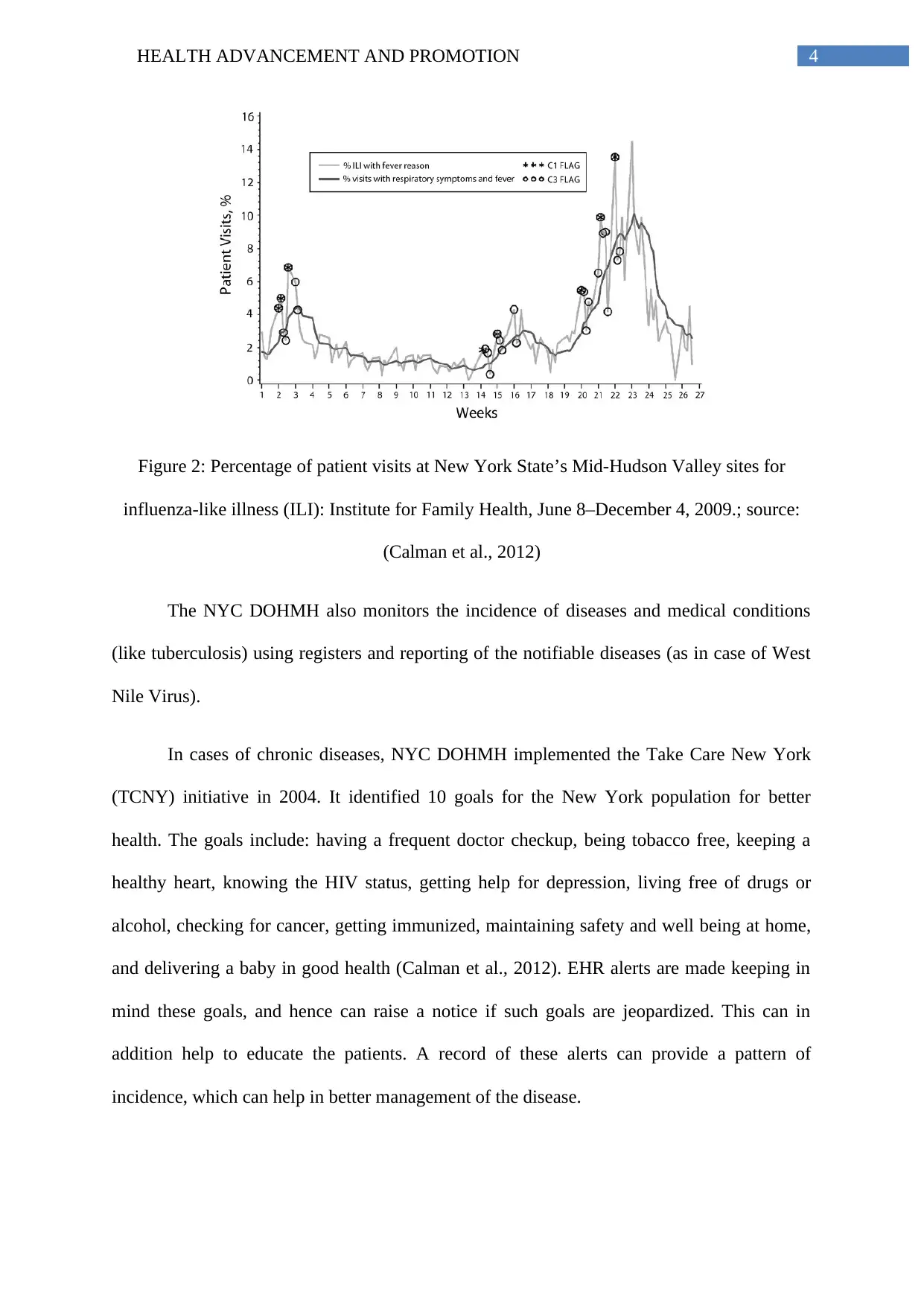
4HEALTH ADVANCEMENT AND PROMOTION
Figure 2: Percentage of patient visits at New York State’s Mid-Hudson Valley sites for
influenza-like illness (ILI): Institute for Family Health, June 8–December 4, 2009.; source:
(Calman et al., 2012)
The NYC DOHMH also monitors the incidence of diseases and medical conditions
(like tuberculosis) using registers and reporting of the notifiable diseases (as in case of West
Nile Virus).
In cases of chronic diseases, NYC DOHMH implemented the Take Care New York
(TCNY) initiative in 2004. It identified 10 goals for the New York population for better
health. The goals include: having a frequent doctor checkup, being tobacco free, keeping a
healthy heart, knowing the HIV status, getting help for depression, living free of drugs or
alcohol, checking for cancer, getting immunized, maintaining safety and well being at home,
and delivering a baby in good health (Calman et al., 2012). EHR alerts are made keeping in
mind these goals, and hence can raise a notice if such goals are jeopardized. This can in
addition help to educate the patients. A record of these alerts can provide a pattern of
incidence, which can help in better management of the disease.
Figure 2: Percentage of patient visits at New York State’s Mid-Hudson Valley sites for
influenza-like illness (ILI): Institute for Family Health, June 8–December 4, 2009.; source:
(Calman et al., 2012)
The NYC DOHMH also monitors the incidence of diseases and medical conditions
(like tuberculosis) using registers and reporting of the notifiable diseases (as in case of West
Nile Virus).
In cases of chronic diseases, NYC DOHMH implemented the Take Care New York
(TCNY) initiative in 2004. It identified 10 goals for the New York population for better
health. The goals include: having a frequent doctor checkup, being tobacco free, keeping a
healthy heart, knowing the HIV status, getting help for depression, living free of drugs or
alcohol, checking for cancer, getting immunized, maintaining safety and well being at home,
and delivering a baby in good health (Calman et al., 2012). EHR alerts are made keeping in
mind these goals, and hence can raise a notice if such goals are jeopardized. This can in
addition help to educate the patients. A record of these alerts can provide a pattern of
incidence, which can help in better management of the disease.
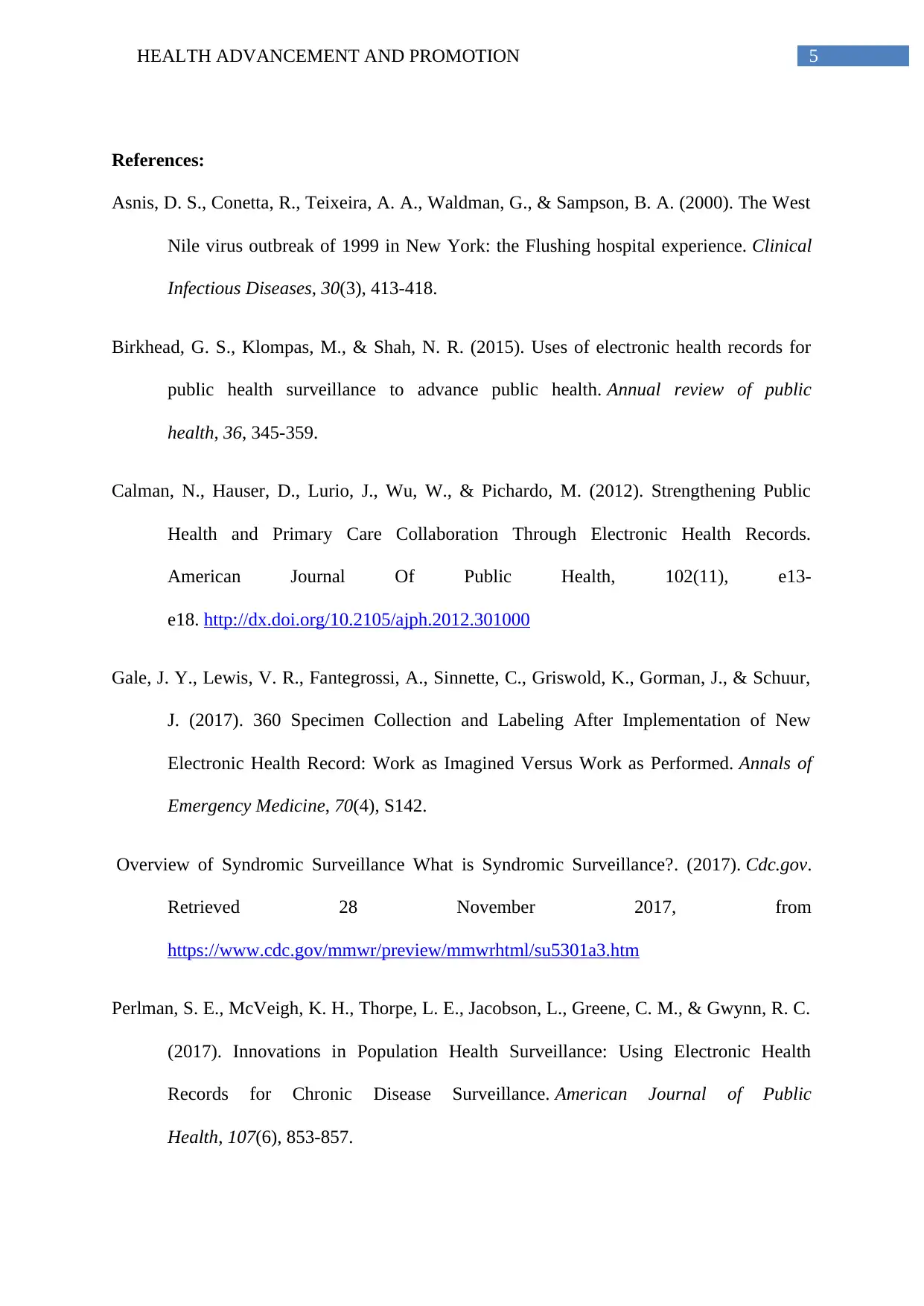
5HEALTH ADVANCEMENT AND PROMOTION
References:
Asnis, D. S., Conetta, R., Teixeira, A. A., Waldman, G., & Sampson, B. A. (2000). The West
Nile virus outbreak of 1999 in New York: the Flushing hospital experience. Clinical
Infectious Diseases, 30(3), 413-418.
Birkhead, G. S., Klompas, M., & Shah, N. R. (2015). Uses of electronic health records for
public health surveillance to advance public health. Annual review of public
health, 36, 345-359.
Calman, N., Hauser, D., Lurio, J., Wu, W., & Pichardo, M. (2012). Strengthening Public
Health and Primary Care Collaboration Through Electronic Health Records.
American Journal Of Public Health, 102(11), e13-
e18. http://dx.doi.org/10.2105/ajph.2012.301000
Gale, J. Y., Lewis, V. R., Fantegrossi, A., Sinnette, C., Griswold, K., Gorman, J., & Schuur,
J. (2017). 360 Specimen Collection and Labeling After Implementation of New
Electronic Health Record: Work as Imagined Versus Work as Performed. Annals of
Emergency Medicine, 70(4), S142.
Overview of Syndromic Surveillance What is Syndromic Surveillance?. (2017). Cdc.gov.
Retrieved 28 November 2017, from
https://www.cdc.gov/mmwr/preview/mmwrhtml/su5301a3.htm
Perlman, S. E., McVeigh, K. H., Thorpe, L. E., Jacobson, L., Greene, C. M., & Gwynn, R. C.
(2017). Innovations in Population Health Surveillance: Using Electronic Health
Records for Chronic Disease Surveillance. American Journal of Public
Health, 107(6), 853-857.
References:
Asnis, D. S., Conetta, R., Teixeira, A. A., Waldman, G., & Sampson, B. A. (2000). The West
Nile virus outbreak of 1999 in New York: the Flushing hospital experience. Clinical
Infectious Diseases, 30(3), 413-418.
Birkhead, G. S., Klompas, M., & Shah, N. R. (2015). Uses of electronic health records for
public health surveillance to advance public health. Annual review of public
health, 36, 345-359.
Calman, N., Hauser, D., Lurio, J., Wu, W., & Pichardo, M. (2012). Strengthening Public
Health and Primary Care Collaboration Through Electronic Health Records.
American Journal Of Public Health, 102(11), e13-
e18. http://dx.doi.org/10.2105/ajph.2012.301000
Gale, J. Y., Lewis, V. R., Fantegrossi, A., Sinnette, C., Griswold, K., Gorman, J., & Schuur,
J. (2017). 360 Specimen Collection and Labeling After Implementation of New
Electronic Health Record: Work as Imagined Versus Work as Performed. Annals of
Emergency Medicine, 70(4), S142.
Overview of Syndromic Surveillance What is Syndromic Surveillance?. (2017). Cdc.gov.
Retrieved 28 November 2017, from
https://www.cdc.gov/mmwr/preview/mmwrhtml/su5301a3.htm
Perlman, S. E., McVeigh, K. H., Thorpe, L. E., Jacobson, L., Greene, C. M., & Gwynn, R. C.
(2017). Innovations in Population Health Surveillance: Using Electronic Health
Records for Chronic Disease Surveillance. American Journal of Public
Health, 107(6), 853-857.
⊘ This is a preview!⊘
Do you want full access?
Subscribe today to unlock all pages.

Trusted by 1+ million students worldwide
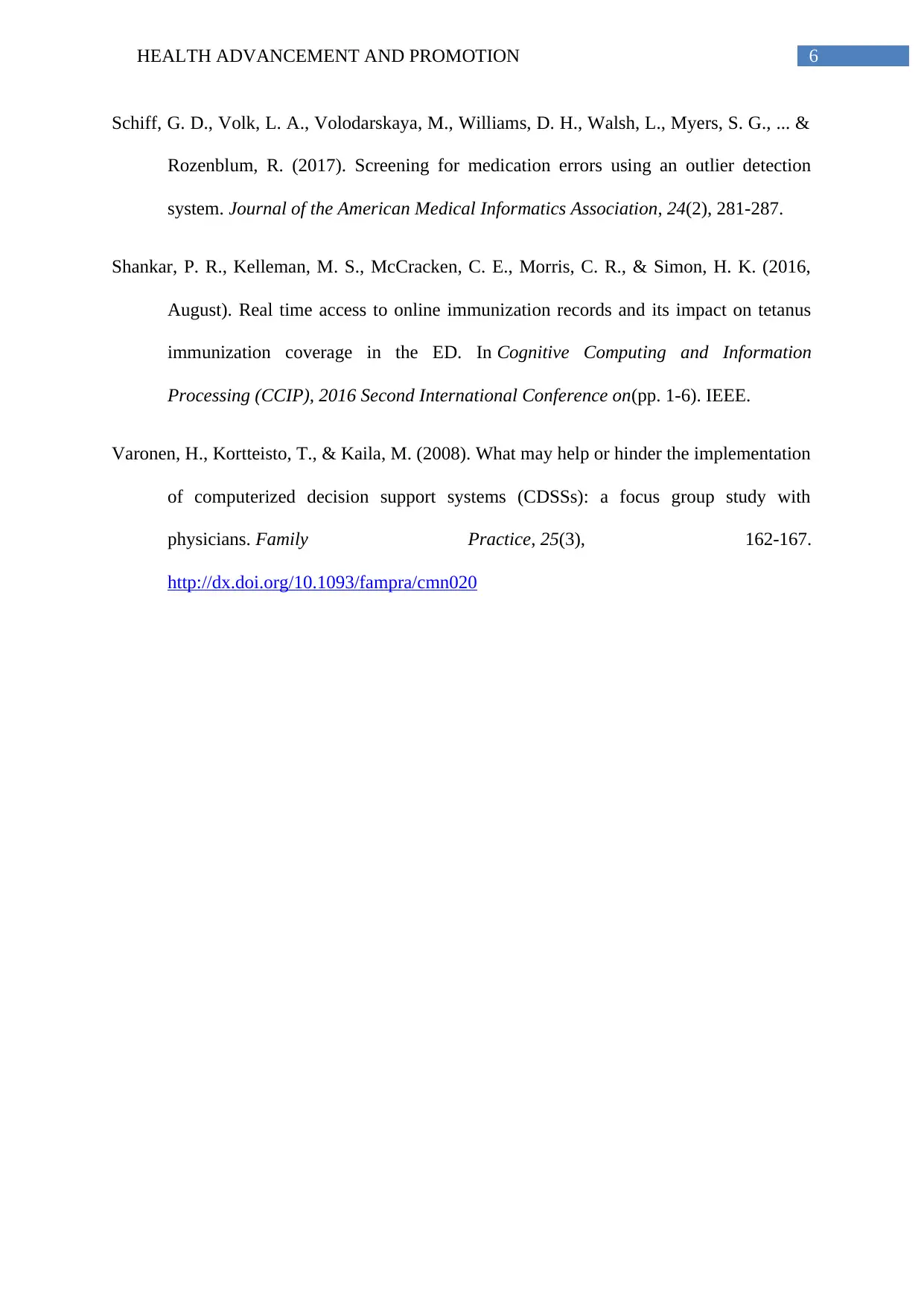
6HEALTH ADVANCEMENT AND PROMOTION
Schiff, G. D., Volk, L. A., Volodarskaya, M., Williams, D. H., Walsh, L., Myers, S. G., ... &
Rozenblum, R. (2017). Screening for medication errors using an outlier detection
system. Journal of the American Medical Informatics Association, 24(2), 281-287.
Shankar, P. R., Kelleman, M. S., McCracken, C. E., Morris, C. R., & Simon, H. K. (2016,
August). Real time access to online immunization records and its impact on tetanus
immunization coverage in the ED. In Cognitive Computing and Information
Processing (CCIP), 2016 Second International Conference on(pp. 1-6). IEEE.
Varonen, H., Kortteisto, T., & Kaila, M. (2008). What may help or hinder the implementation
of computerized decision support systems (CDSSs): a focus group study with
physicians. Family Practice, 25(3), 162-167.
http://dx.doi.org/10.1093/fampra/cmn020
Schiff, G. D., Volk, L. A., Volodarskaya, M., Williams, D. H., Walsh, L., Myers, S. G., ... &
Rozenblum, R. (2017). Screening for medication errors using an outlier detection
system. Journal of the American Medical Informatics Association, 24(2), 281-287.
Shankar, P. R., Kelleman, M. S., McCracken, C. E., Morris, C. R., & Simon, H. K. (2016,
August). Real time access to online immunization records and its impact on tetanus
immunization coverage in the ED. In Cognitive Computing and Information
Processing (CCIP), 2016 Second International Conference on(pp. 1-6). IEEE.
Varonen, H., Kortteisto, T., & Kaila, M. (2008). What may help or hinder the implementation
of computerized decision support systems (CDSSs): a focus group study with
physicians. Family Practice, 25(3), 162-167.
http://dx.doi.org/10.1093/fampra/cmn020
1 out of 7
Related Documents
Your All-in-One AI-Powered Toolkit for Academic Success.
+13062052269
info@desklib.com
Available 24*7 on WhatsApp / Email
![[object Object]](/_next/static/media/star-bottom.7253800d.svg)
Unlock your academic potential
Copyright © 2020–2025 A2Z Services. All Rights Reserved. Developed and managed by ZUCOL.




